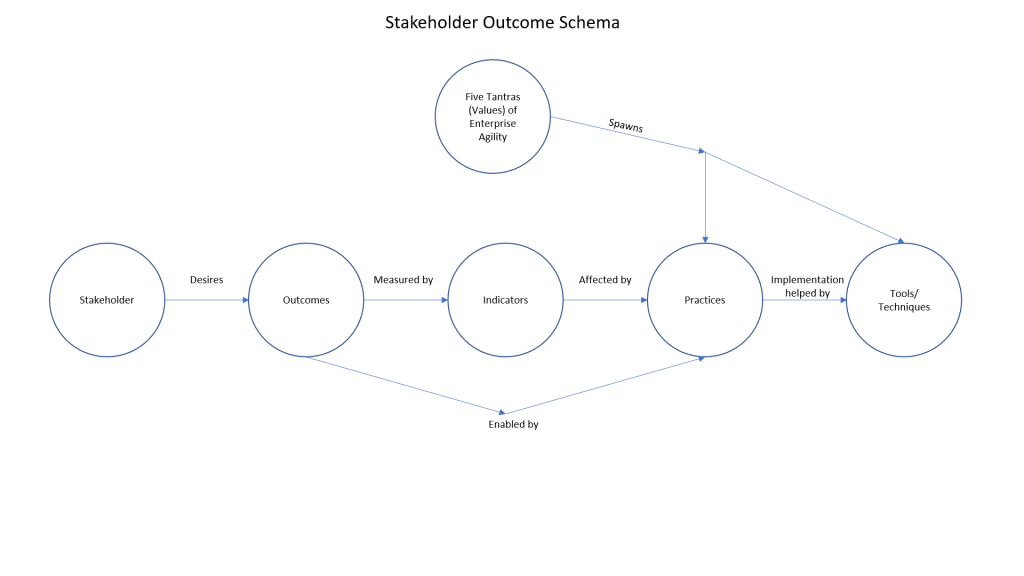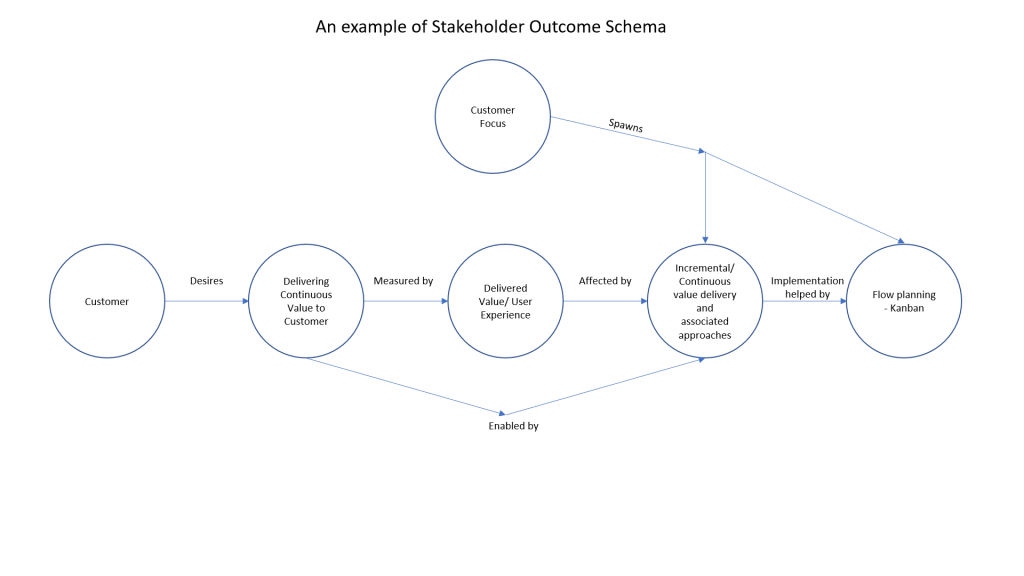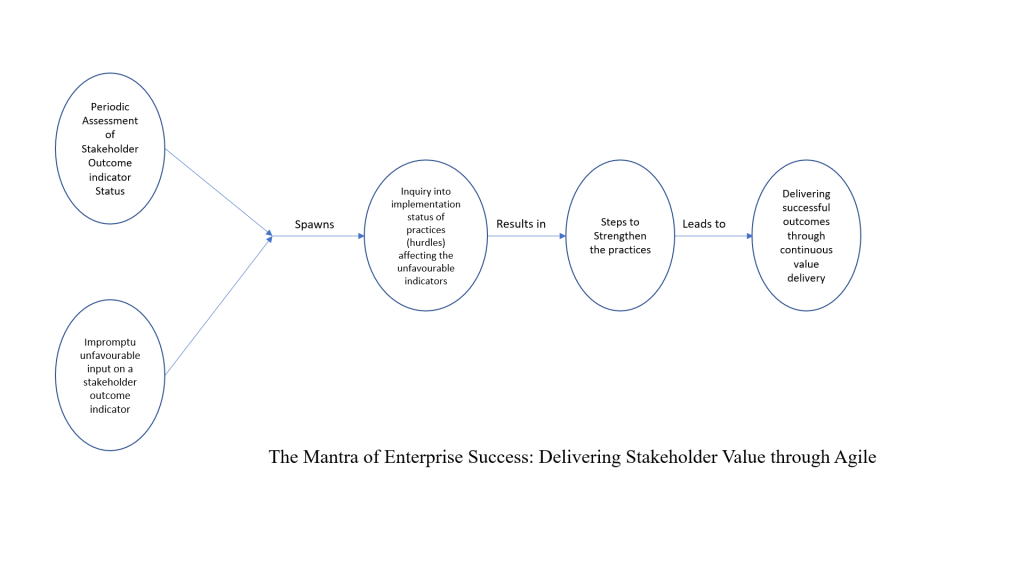An enterprise exists to deliver value to its stakeholders (Customers, Associates and Shareholders). Continuous delivery of value to stakeholders is the mantra that industry leaders now chant in their offices all day long. Now, how do they deliver this continuous value? People are now sold on Agile as the approach to develop products and services in a way that will deliver value continuously. Time and again, Agile has proven to be more flexible and effective in responding to change than other, traditional approaches. With Agile, customers and stakeholders get the best outcomes as they are engaged in the process of absorbing continuous value.
How does each stakeholder realise the required value? Now, each stakeholder desires certain outcomes from dealing with/ being part of/ investing in this organisation. If these outcomes are successfully got by the stakeholder, we can say that he has realized the required value.
Let us take the stakeholder Customer as an example.
Value is measured against, or is about, customer outcomes. That is, a desired outcome, which is a combination of the required outputs of an implemented feature and the right user experience, is the value the customer and any end-user gets. That is, an outcome or value is not just the output. It is output plus the right experience.
For example, if your customer wants a facility to re-open a cancelled order, you can either tell them to just create a new order, or provide the facility to tweak the cancelled order back into existence. The second approach obviously give the customer the better experience or value, though both approaches give the same output.
As we see, one key outcome that a successful enterprise needs to provide is Delivering Continuous value to customer. And the key indicator (among possibly others) of the success of this outcome is Delivered value/User experience. That is, if the customer is happy with the indicator , and is prepared to give it high marks, it means that the desired outcome is being realised.
But what if the outcome is not successfully realized by the stakeholder? What are the reasons or hurdles that stand in the way of this outcome being successfully realized? In the previous example, the customer would have been unhappy with his experience if the first approach to solving the problem had been adopted.
Now the reason for taking the simple way out, by recommending that a cancelled order be reopened by a process of opening a new order, could have been due to a breakdown in the practices that lead to the delivery of continuous value – maybe a problem with proper prioritisation of story backlogs.
How do we ensure that we overcome or jump over these hurdles? How do we ensure that this outcome above is properly delivered, so that the indicator returns a good score?
This is where the five tantras or values of enterprise Agility mentioned in PM Power’s manifesto, PM Power Enterprise Agile Transformation Manifesto and our book, The Five Tantras of Enterprise Agility (the above two together will be referred to as The Five Tantras) come in.

[Please don’t get confused between the usage of the word ‘values’ here in the context of the phrase the ‘values of Agility’ and the word value we used earlier in the phrase “value delivered to the customer”. The word ‘value’, as used in customer outcomes, means the worth or usefulness of something, while the same word, when used in the Enterprise Agile Transformation Manifesto, means a standard of behaviour – one’s judgement of what is important in an Agile organisation.]
The first value or tantra mentioned there, Focus on Customer Outcomes, when implemented fully, would have spawned a set of practices in the Agile organisation. Implementing these practices properly ensures that these hurdles to delivering the required stakeholder outcomes and values are removed.

One of these practices would have been Incremental / continuous value delivery and associated approaches. The need to be customer centric / customer focused is the primary driver for defining and implementing approaches that support incremental / continuous value delivery. This requires, among others
- Understanding and alignment to customer needs
- Addressing unstated needs
- Prioritizing business value for user needs and ensuring delivery of just enough value
- Ensuring the required focus on customer / user experience
This practice is needed because having a vision for a specific project context or from a customer perspective provides a big picture for everyone in the team. Everyone understanding and aligning to this big picture will help provide the best value and experience for a customer for the efforts put in by the team. So, implementing this practice (Incremental / continuous value delivery and associated approaches) successfully will go a long way towards delivering the outcome Delivering Continuous value to customer.
Now, what are the tools and techniques that help in implementing this practice? The detailing of the practices under the first value, Customer Focus, mentioned in The Five Tantras, would also need the identification and explanation of a set of tools and techniques that help in implementing these practices.
What do these tools/ techniques look like? Let us take an example of a tool/ technique that enables the implementation of the practice we saw before – Flow planning – Kanban.
This tool/ technique involves the following steps:
- Map the end-to-end business flow (use any process flow diagramming tools)
- Identify the technical sub processes and the business sub processes (use any process flow diagramming tools)
- Identify the key steps and map them on a Kanban board
- Identify Work in Progress Limits (WIP limits) for every stage. These are computed based on the bandwidth available and the efforts it would take to progress a work item
- Track the ‘cycle times’ and ‘lead times’ periodically to identify opportunities for improvement.

This tool/ technique makes sense for helping the implementation of the practice. Agile approaches recommend small, frequent increments of work to be the preferred ways of working. Having smaller batches has been found to increase the flow and the overall throughput of any system. When one breaks down a large product or solution into smaller portions, many opportunities open up for creating early prototypes that could be used to validate new concepts. This will avoid the cost of experimentation and also reduce the cost of invalidated assumptions. This will certainly enable Incremental / continuous value delivery and associated approaches.
In the foregoing discussion we have traced how a desired outcome like Delivering Continuous value to customer can be delivered to the stakeholder by implementing practices ( for e.g., Incremental / continuous value delivery and associated approaches) and corresponding tools and techniques (for e.g., Flow planning – Kanban). that are spawned off for implementing Agile values recommended by The Five Tantras.
PM Power’s book, The Five Tantras of Enterprise Agility, does not go into the details of the Agile practices and the tools and techniques required to implement these practices. However, many of the readers of the book have written to PM Power asking for a sequel to the book which explains in detail the stakeholder outcomes, the Agile practices needed to successfully deliver these outcomes and the tools and techniques that help in enabling these practices. Based on this, we are in the process of writing a book called The Mantra of Enterprise Success: Delivering Stakeholder Value through Agile, which is a sequel to the book. We expect the book to be available for reading by the end of 2022.




